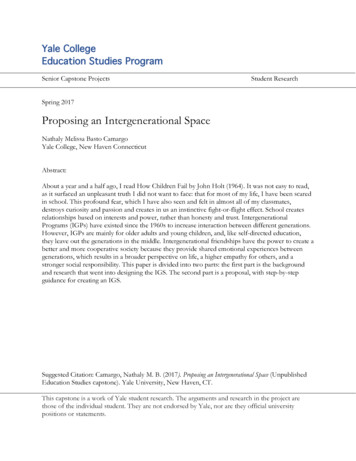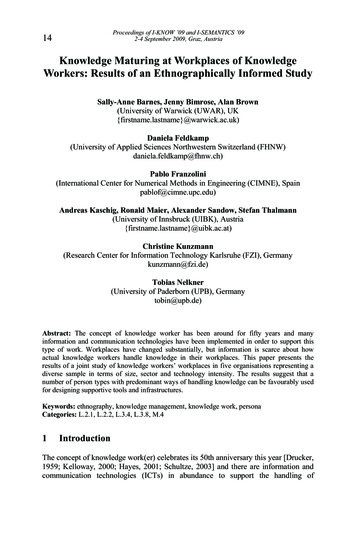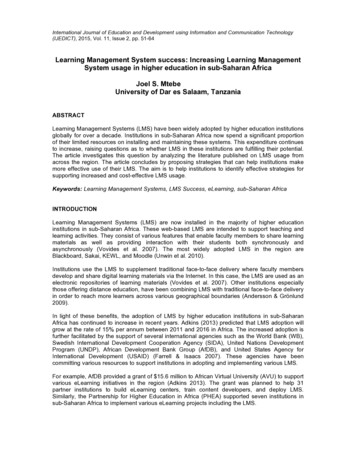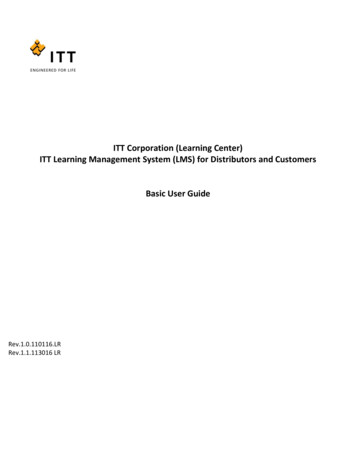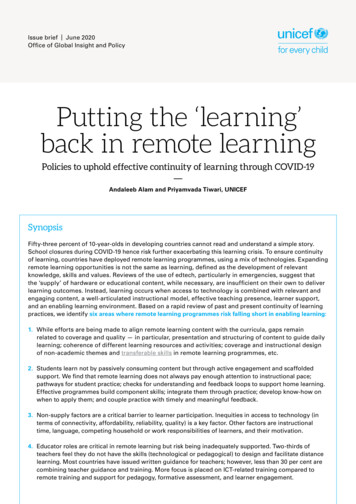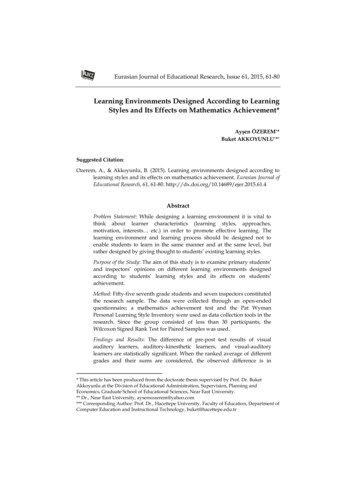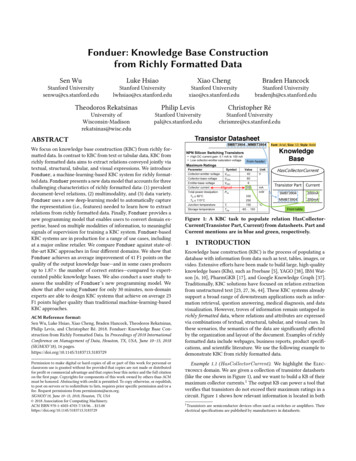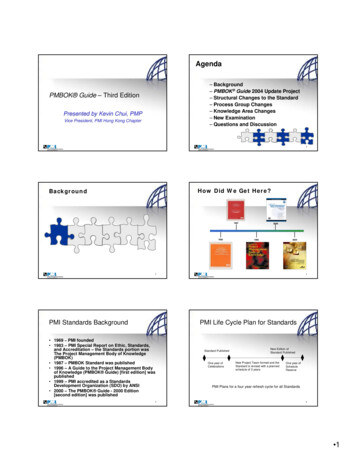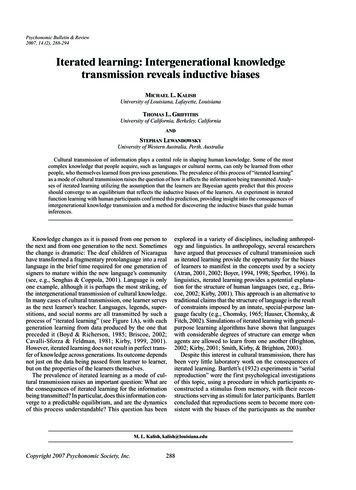
Transcription
Psychonomic Bulletin & Review2007, 14 (2), 288-294Iterated learning: Intergenerational knowledgetransmission reveals inductive biasesMICHAEL L. KALISHUniversity of Louisiana, Lafayette, LouisianaTHOMAS L. GRIFFITHSUniversity of California, Berkeley, CaliforniaANDSTEPHAN LEWANDOWSKYUniversity of Western Australia, Perth, AustraliaCultural transmission of information plays a central role in shaping human knowledge. Some of the mostcomplex knowledge that people acquire, such as languages or cultural norms, can only be learned from otherpeople, who themselves learned from previous generations. The prevalence of this process of “iterated learning”as a mode of cultural transmission raises the question of how it affects the information being transmitted. Analyses of iterated learning utilizing the assumption that the learners are Bayesian agents predict that this processshould converge to an equilibrium that reflects the inductive biases of the learners. An experiment in iteratedfunction learning with human participants confirmed this prediction, providing insight into the consequences ofintergenerational knowledge transmission and a method for discovering the inductive biases that guide humaninferences.Knowledge changes as it is passed from one person tothe next and from one generation to the next. Sometimesthe change is dramatic: The deaf children of Nicaraguahave transformed a fragmentary protolanguage into a reallanguage in the brief time required for one generation ofsigners to mature within the new language’s community(see, e.g., Senghas & Coppola, 2001). Language is onlyone example, although it is perhaps the most striking, ofthe intergenerational transmission of cultural knowledge.In many cases of cultural transmission, one learner servesas the next learner’s teacher. Languages, legends, superstitions, and social norms are all transmitted by such aprocess of “iterated learning” (see Figure 1A), with eachgeneration learning from data produced by the one thatpreceded it (Boyd & Richerson, 1985; Briscoe, 2002;Cavalli-Sforza & Feldman, 1981; Kirby, 1999, 2001).However, iterated learning does not result in perfect transfer of knowledge across generations. Its outcome dependsnot just on the data being passed from learner to learner,but on the properties of the learners themselves.The prevalence of iterated learning as a mode of cultural transmission raises an important question: What arethe consequences of iterated learning for the informationbeing transmitted? In particular, does this information converge to a predictable equilibrium, and are the dynamicsof this process understandable? This question has beenexplored in a variety of disciplines, including anthropology and linguistics. In anthropology, several researchershave argued that processes of cultural transmission suchas iterated learning provide the opportunity for the biasesof learners to manifest in the concepts used by a society(Atran, 2001, 2002; Boyer, 1994, 1998; Sperber, 1996). Inlinguistics, iterated learning provides a potential explanation for the structure of human languages (see, e.g., Briscoe, 2002; Kirby, 2001). This approach is an alternative totraditional claims that the structure of language is the resultof constraints imposed by an innate, special-purpose language faculty (e.g., Chomsky, 1965; Hauser, Chomsky, &Fitch, 2002). Simulations of iterated learning with generalpurpose learning algorithms have shown that languageswith considerable degrees of structure can emerge whenagents are allowed to learn from one another (Brighton,2002; Kirby, 2001; Smith, Kirby, & Brighton, 2003).Despite this interest in cultural transmission, there hasbeen very little laboratory work on the consequences ofiterated learning. Bartlett’s (1932) experiments in “serialreproduction” were the first psychological investigationsof this topic, using a procedure in which participants reconstructed a stimulus from memory, with their reconstructions serving as stimuli for later participants. Bartlettconcluded that reproductions seem to become more consistent with the biases of the participants as the numberM. L. Kalish, kalish@louisiana.eduCopyright 2007 Psychonomic Society, Inc.288
ITERATED LEARNINGAhypothesisdataBd0p( h d)hypothesisdatah1p( d h )289d1.datap( h d)h2p( d h )d2p( h d).Figure 1. (A) Iterated learning. Each learner sees data produced by a learner in a previous generation, forms a hypothesis about the process by which those data were produced,and uses this hypothesis to produce the data that will be supplied to a learner in the nextgeneration. (B) Iterated learning with Bayesian agents. The first learner sees data d0, computes a posterior probability distribution over hypotheses according to Equation 1, samplesa hypothesis h1 from this distribution, and generates new data d1 by sampling from the likelihood associated with that hypothesis. These data are provided to the second learner, andthe process continues, with the nth learner seeing data dn 1, inferring a hypothesis hn, andgenerating new data dn.of reproductions increases. However, these claims areimpossible to validate, since Bartlett’s experiments usedstimuli, such as pictures and stories, that are not particularly amenable to rigorous analysis. In addition, there wasno unambiguous preexperimental hypothesis about whatpeople’s biases might be for these complex stimuli. Therehave been only a few subsequent studies in serial reproduction, with the most prominent being Bangerter (2000)and Barrett and Nyhof (2001), and thus we currently havelittle understanding of the likely outcome of iterated learning in controlled conditions. The possibilities are numerous: Iteration might produce divergence from structureinto noise or into random or unpredictable alternation fromone solution to another, or people might blend their biaseswith the data to form consistent “compromise” solutions.In this article, we attempt to determine the outcome ofintergenerational knowledge transmission by testing thepredictions made by a formal analysis of iterated learningin an experiment using a controlled set of stimuli.We can gain some insight into the consequences of iterated learning by considering the case in which learnersare Bayesian agents. Bayesian agents use a principle ofprobability theory, called Bayes’s rule, to infer the process that was responsible for generating some observeddata. Assume that a learner has a set of hypotheses, H,about the process that could have produced the data, d, andthat a “prior” probability distribution, p(h), encodes thatlearner’s biases by specifying the probability the learnerassigns to the truth of each hypothesis h a H before seeing d. In the case of learning a language, the hypotheses, h,are different languages, and the data, d, are a set of utterances. Bayes’s rule states that the probability that an agentshould assign to each hypothesis after seeing d—knownas the “posterior” probability, p(h d)—isp( h d )p( d h ) p( h ),p( d )(1)where p(d h)—the “likelihood”—indicates how likely dis under hypothesis h, and p(d) is the probability of d av-eraged over all hypotheses, p(d) h p(d h) p(h), sometimes called the prior predictive distribution. The assumption that learners are Bayesian agents is not unreasonable:Adherence to Bayes’s rule is a fundamental principle ofrational action in statistics and economics (Jaynes, 2003;Robert, 1994; Savage, 1954), and its use underlies manylearning algorithms (MacKay, 2003; Mitchell, 1997).In iterated learning with Bayesian agents, each learneruses Bayes’s rule to infer the hypothesis used by the previous learner and generates the data provided to the nextlearner using the results of this inference (see Figure 1B).Having formalized iterated learning in this way, we canexamine how it affects the hypotheses chosen by the learners. The probability that the nth learner chooses hypothesis i given that the previous learner chose hypothesis j isp hn i hn 1 j p hn i ddp d hn 1 j ,(2)where p(hn i d ) is the posterior probability obtainedfrom Equation 1. This specifies the transition matrix of aMarkov chain, with the hypothesis chosen by each learnerdepending only on that chosen by the previous learner.Griffiths and Kalish (2005) showed that the stationary distribution of this Markov chain is p(h), the prior assumedby the learners. The Markov chain will converge to thisdistribution under fairly general conditions (see, e.g.,Norris, 1998), so the probability that the last in a long lineof learners chooses a particular hypothesis is simply theprior probability of that hypothesis, regardless of the dataprovided to the first learner. In other words, the stimuliprovided for learning are completely irrelevant in the longrun, and only the biases of the learners affect the outcomeof iterated learning.1A similar convergence result can be obtained if we consider how the data generated by the learners (instead of thehypotheses they hold) change over time: After many generations, the probability that a learner generates data d willbe p(d) h p(d h) p(h), the probability of d under the
290KALISH, GRIFFITHS, AND LEWANDOWSKYn 1ACorrelationBn 2n 3n 4n 545n 6n 7n 8n 91.50 .5 11236789Iteration (n)Figure 2. Iterated learning with Bayesian agents converging to the prior. (A) The leftmost panel shows the initial data provided to aBayesian learner, a sample of 20 points from a function. The learner inferred a hypothesis (in this case, a linear function) from thesedata, and then generated the predicted values of y shown in the next panel for a new set of inputs x. These predictions were supplied asdata to another Bayesian learner, and the remaining panels show the predictions produced by learners in each generation as this process continued. All learners had a prior distribution over hypotheses favoring linear functions with positive slope (see the Appendix fordetails). As iterated learning proceeded, the predictions converged to a positive linear function. (B) The correlation between predictionsand the function y x provides a quantitative measure of correspondence to the prior. The solid line shows the median correlationwith y x for functions produced by 1,000 sequences of iterated learning like that shown in row A. The dotted lines show the 95%confidence interval. Using this quantitative measure, it is easy to see that iterated learning quickly produces a strong correspondenceto the prior.prior predictive distribution (Griffiths & Kalish, in press).This process of convergence is illustrated in Figure 2 forthe case in which the hypotheses are linear functions andthe prior favors functions with unit slope and zero intercept (the details of this Bayesian model appear in the Appendix). This is a simple example of iterated learning, butone that is nonetheless illustrative of convergence to theprior predictive distribution. As each generation of learners combines the evidence provided by the data with their(common) prior, their posterior distributions move closerto the prior, and the data they produce become more consistent with hypotheses that have high prior probability.The preceding analysis of iterated learning with Bayesian agents provides a simple answer to the question of howiterated learning affects the information being transmitted: The information will be transformed to reflect the inductive biases of the learners. Whether a similar transformation will be observed with human learners is an openempirical question. To test this prediction, we reproducediterated learning in the laboratory using a set of controlledstimuli for which people’s biases are well understood. Wechose to use a function learning task, because of the prominent role that inductive bias seems to play in this domain.2In function learning, each learner sees data consisting of(x, y) pairs and attempts to infer the underlying functionthat relates y to x. Experiments typically present the values of x graphically, and participants produce a graphical y magnitude in response. Tests of interpolation andextrapolation with novel x values reveal that people infercontinuous functions from these discrete trials. Previousexperiments in function learning suggest that people havean inductive bias favoring linear functions with a positive slope: Initial responses are consistent with such functions (Busemeyer, Byun, DeLosh, & McDaniel, 1997),and those functions require the least training to learn(Brehmer, 1971, 1974; Busemeyer et al., 1997). Kalish,Lewandowsky, and Kruschke (2004) showed that a modelthat included such a bias could account for a variety ofphenomena in human function learning. If iterated learning converges to an equilibrium reflecting the inductivebiases of the learners, we should expect to see linear functions with positive slope emerge after a few generationsof learners. We tested this hypothesis by examining theoutcome of iterated function learning, varying the functions used to train the first learner in each sequence.METHODParticipantsA total of 288 undergraduate psychology students from the University of Louisiana at Lafayette participated for partial coursecredit. The experiment had four conditions, corresponding to different initial training functions. There were 72 participants in eachcondition, forming nine generations of learners in eight “families”;the responses of each generation of learners during a posttrainingtransfer test were presented to the next generation of learners as theto-be-learned target stimuli.Apparatus and StimuliParticipants completed the experiment in individual soundattenuated booths. A computer displayed all trials and was used tocollect all responses. On each trial, a filled blue bar 1 cm high andfrom 0.3 cm (x 1) to 30 cm (x 100) wide was presented as thestimulus. The stimulus was always presented in the upper portion ofthe screen, with its upper left corner approximately 4 cm from thetop and 4 cm from the left of the edge of the screen. Each participantentered a response magnitude by adjusting a vertically oriented unmarked slider (located 4 cm from the bottom and 6 cm from the rightof the screen) with the mouse; the slider’s position determined theheight of a filled red bar 1 cm wide that could extend up to 25 cm.During the training phase, feedback was provided in the form of a
ITERATED LEARNINGfilled yellow bar 1 cm wide placed 1 cm to the right of the responsebar, which varied from 0.25 cm ( y 1) to 25 cm (y 100) in heightand was aligned so that the height of the bar was aligned with thecorrect response.ProcedureThe experiment had both training and transfer phases. For thelearners who formed the first generation of any family, the valuesof the training stimuli were 50 randomly selected stimulus values(x) ranging from 1 to 100 paired with feedback ( y) given by thefunction of the condition the participant was in. The four functionsused during training of the first generation of participants in the fourconditions were y x (positive linear), y 101 x (negative linear), y 50.5 49.5 sin[ /2 x/(5 )] (nonlinear, U-shaped), andrandom one-to-one pairings of x- and y-coordinates in which bothx, y a{1, . . . , 100}. All values of x were integers and all values of ywere rounded to the nearest integer prior to display.The test items consisted of 25 of the training items, along with25 of the 50 unused stimulus values. Intergenerational transfer tookplace by making the test stimuli and responses of generation n ofeach family serve as the training items of generation n 1 of thatfamily. Intergenerational transfer was conducted entirely withoutpersonal contact, and participants were not made aware that theirtest responses would serve as training for later participants; the useof one generation’s test items in training the next generation was theonly contact between generations.Each trial was initiated by the presentation of a stimulus, selectedwithout replacement from the 50 items in either the training or testset. Following each stimulus presentation, while the stimulus remained on the screen, the participant used the mouse to adjust theslider to indicate a predicted response magnitude, clicking a buttonto record the response when they had adjusted the slider to the desired magnitude. The response could be manipulated ad lib until theparticipant chose to record it.During training, each response was followed by the presentationof a feedback bar. If the response was correct (defined as within1.5 cm, or 5 units, of the target value y), there was a study intervalof 1-sec duration during which the stimulus, response, and feedbackwere all presented. If the response was incorrect, a tone soundedand the participant was shown the feedback bar. The participant wasthen required to set the slider so that the response bar matched thefeedback bar. A study interval of 2-sec duration followed this correction. Thus, participants who responded accurately spent less timestudying the feedback; this was the reward for accurate responses.After each study interval, there was a blank interval of 2 sec beforethe next trial. Each participant completed a single block of training in which each of the 50 training values was presented once inrandom order. Test trials were identical to training trials, except thatno feedback was made available after the response was entered. Participants were informed prior to the beginning of the test phase aboutthis change.RESULTSFigure 3 shows a single family of 9 participants foreach condition, chosen to be representative of the overallresults. Each set of axes shows the test-phase responses ofa single learner who was trained using the data shown inthe graph to its left. For example, the responses of the firstgeneration in each condition (in column 2) were basedon the data provided by the actual function (to the left,in column 1). The responses of the second generation (incolumn 3) were based on the data produced by the firstgeneration (in column 2), and so forth.Regardless of the data seen by the first learner, iteratedlearning converged in only a few generations to a linearfunction with positive slope for 28 of the 32 families of291learners. Figure 3A indicates that a linear function withpositive slope was stable under iterated learning; none ofthe other initial conditions had this level of stability. Figure 3B is reminiscent of the analysis shown in Figure 2:Despite starting with a linear function with negative slope,learners converged to a linear function with positive slope.Figures 3C and 3D show that linear functions with positiveslope also emerge from iterated learning when the initialfunction is nonmonotonic or completely random. The positive linear function was not the only one to appear duringiterated learning, however. In 2 of the random-conditionand 1 of the nonlinear-condition families, participants produced clear negative linear response functions for one ormore generations, as did all 8 families in the negative condition. Thus, 11 families overall transmitted the negativelinear function at least once. Of these, 3 (2 in the negativeand 1 in the random condition) converged to the negativefunction, and 1 did not converge at all by the end of ninegenerations. Figure 3E shows the family that produced andthen maintained the negative linear function.The results shown in Figure 3 illustrate an overall tendency for iterated learning to converge to a positive linear function. To provide a more quantitative analysis, wecomputed the correlation between the responses of eachparticipant and the positive linear function y x. Theoutliers produced by families converging to the negativelinear function made the mean correlation less informative than the median; Figure 3F shows the median correlations at each generation for each of the four conditions. Other than the positive linear condition, in whichthe correlation was at ceiling from the first generation,the correlations systematically increased across
intergenerational knowledge transmission and a method for discovering the inductive biases that guide human inferences. Psychonomic Bulletin & Review 2007, 14 (2), 288-294 M. L.
